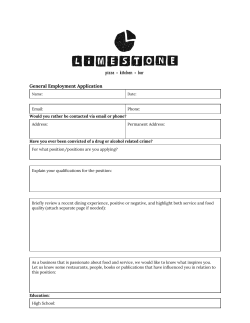
Which Limestone Should You Use?
Extension and Advisory Team Which Limestone Should You Use? The quality of limestone found in a quarry can vary. The degree of variation in quality depends the amount of non-carbonate minerals (impurities like clay, quartz sand, organic matter, etc.) in the sediment. The calcium carbonate equivalent (CCE) compares the chemistry of a particular quarry’s limestone with the neutralizing power of pure calcium carbonate. Fineness of a ground limestone determines how fast it will act to neutralize soil acidity. A finer grind increases the surface area which will increase the contact between the soil and lime particle and therefore increase the opportunity to react. By combining the chemistry of a particular product (CCE) and its particle size the Effective Calcium Carbonate Equivalent (ECCE) can be determined. Fineness is measured by how much material passes through different mesh sieves. The larger the sieve number, the smaller the mesh openings and the finer the material needs to be to pass through (see top photo at right). There are many other factors that affect how quickly the lime will react in soil including temperature, moisture, organic matter content, soil texture, soil management practices etc. As a result, it is difficult to accurately predict reaction times. However, generalizations regarding particle size and reaction times have been developed. There can be slight differences among provinces and states in sieve sizes and efficiency factors used for calculating the ECCE. The following sieves sizes and efficiency factors are used by Sharifi et al. (2013): • Particles that pass through a 100 mesh sieve will react 100 percent with the soil in six months or less. • Particles that pass through a 60 mesh or finer sieve will react 100 percent within the first year (pictured at right) • Particles that pass through a 10 mesh (screen pictured lower right is 10 mesh), but not a 60 mesh, will react 40 percent in the first year • Particles that do not pass through a 10 mesh are considered to have little liming value and will not react in a reasonable amount of time. Some estimates suggest that only 15% of these larger particles will react in four years. Particle sizes between sieve sizes 8 and 20 have been estimated to have a reaction rate of 45% in four years. Using the CCE and the Efficiency factor that corresponds with each particle size, the effective calcium carbonate equivalent (ECCE) rating can be calculated. The ECCE essentially gives an estimation of what percentage of calcium carbonate will react within the first year of application based on particle size. “The product with the lowest cost per kilogram of ECCE material is the best buy, since a kilogram of ECCE material will neutralize the same amount of acidity regardless of the source.” For Example: A limestone sample has the following properties: Using this information the Effective Rating of the Product can be calculated as in the table below. In this case the ECCE would be 25.73%. (CCE*Effective rating of product =83.5*0.31) On a tonne basis, this limestone would contain 257 kg of effective liming material within the first year. Typically the aglime materials in commercial use will have ECCE ranging from 45 percent to 110 percent so this would be considered a low quality liming material. To determine whether this is cost effective in an annual context, the price per tonne should be divided by the kilograms of effective liming material (ECCE) to get price per effective liming material. One lime product may have a higher ECCE, but also may have a higher cost. The product with the lowest cost per kilogram of ECCE material is the best buy, since a kilogram of ECCE material will neutralize the same amount of acidity regardless of the source. *Use the Truckers Association of NS gravel rates as general guidelines if shipping rates are not available http://www.tans.ca/pdf/Gravel%20Rates%202014.pdf. If the goal is to maintain soil pH rather than increase it within a year, comparison based on the CCE might also be useful as a slower pH change over time could be achieved with limestone that has particle sizes that will react over the course of a few years. This method can also be used to evaluate other soil amendments that have a pH neutralizing value. Keep in mind however that many of these amendments, for example wood ash, also contain nutrients so value should also be given to the nutrient content of these other amendments to facilitate decision making. For more information, contact: Amy Sangster, Soils Specialist Extension and Advisory Services Team Perennia Tel: (902)896-0277 Email: asangster@perennia.ca April 2015
© Copyright 2025









